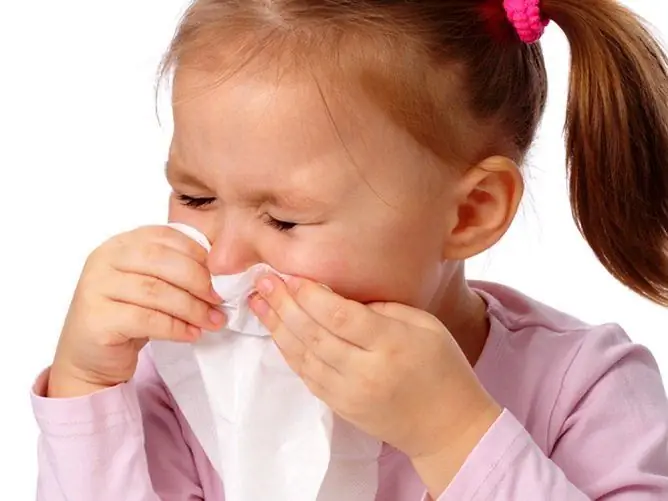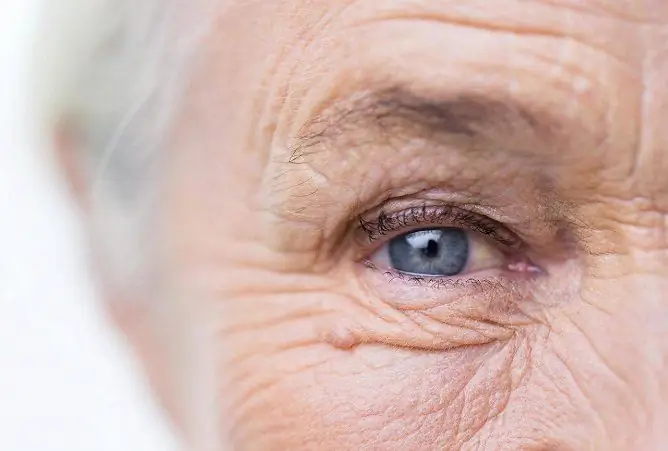- Author Rachel Wainwright [email protected].
- Public 2023-12-15 07:39.
- Last modified 2025-11-02 20:14.
How to treat sinusitis at home in children and adolescents 3-16 years old
The content of the article:
- Clinical manifestations
- Diagnostics
-
Treatment
Treatment of sinusitis in children at home
- Video
Sinusitis, or inflammation of the maxillary sinus, occupies a large place among infectious and inflammatory diseases of the ENT organs in children. Depending on the course of the process, an acute and chronic course of the disease is distinguished.

Therapy of sinusitis at home in children should be carried out in consultation with the attending physician
The etiological factor determines not only the symptoms, but also the further selection of therapy. The most common cause of inflammation in both babies and adolescents is viruses or bacteria that have entered through the upper respiratory tract, in particular against the background of ARVI (acute respiratory viral infection) or childhood infections, such as measles, rubella, scarlet fever and others.
The anatomical and functional features of the child's body, as well as predisposing factors, are of great importance.
The paranasal sinuses in children under 3 years of age are underdeveloped and are formed during the development and growth of the child. At birth, the maxillary sinus is a diverticulum or protrusion of the nasal mucosa in the form of a narrow slit located at the inner corner of the orbit in the thickness of the cancellous bone of the upper jaw. Up to 6-8 years, the sinuses grow slowly. After 6 years, their accelerated development is observed up to 12-16 years.
The outlet opening of the maxillary sinus in young children is relatively narrower and longer than in adults.
The entire dental system of a child from birth is abundantly supplied with blood due to active growth, which contributes to the rapid flow and spread of inflammatory processes in the upper jaw and maxillary sinus.

Paranasal sinuses in children are formed up to 12-16 years
In the younger age group and up to 11-12 years, sinusitis often occurs against the background of childhood infections.
Congenital narrowness of the nasal passages, deformation of the nasal septum, abnormal structure or traumatic damage to the upper jaw or paranasal sinuses predispose to stagnant processes and the addition of a bacterial infection in the sinus cavity.
Adenoid vegetation, against the background of which the aeration of the sinuses is disturbed and inflammation often occurs, reach a maximum development at 4-6 years.
Purulent-septic and intracranial complications develop rapidly due to the functional immaturity of organs and systems, in particular in conditions of reduced immunity.
Complications such as a pharyngeal abscess or otitis media are more common in children 3 years of age or younger.
Clinical manifestations
Symptoms of sinusitis include:
- an increase in body temperature above 38 ° C;
- general weakness, lethargy, apathy;
- the appearance of nasalness;
- persistent or recurrent headaches;
- increased pain when touching the nose, bridge of the nose, cheeks over the affected area;
- discharge from the nose of a stringy serous or purulent exudate;
- unpleasant putrid odor from the mouth or nose;
- decreased or loss of appetite.
Diagnostics
In order for the treatment of sinusitis at home in children to quickly give a positive effect, it is necessary to conduct a comprehensive examination.

To diagnose the disease, a comprehensive examination is required
Complaints and anamnesis data in children of the younger age group are often minimal, which creates particular difficulties in the initial diagnosis. Pain assessment depends on the child's patience. It should be borne in mind that children tend to hide their feelings in order to avoid examination. So, examination of a child of 5 years old and 10 years old can differ significantly.
A clinical blood test with determination of ESR (erythrocyte sedimentation rate) reveals signs of inflammation: leukocytosis with a shift of the leukocyte formula to the left in bacterial infection or with lymphocytosis in viral lesion; increased ESR.
The immaturity of the child's body contributes to a more vivid clinical picture of inflammation. During rhinoscopy - examination of the nasal cavity and the area of the sinus outlet, swelling, hyperemia of the nasal concha mucosa, mucous, serous or purulent discharge are determined.
X-rays of the paranasal sinuses can be done in babies from birth. It allows you to establish the degree of development of the maxillary sinuses, localization, prevalence and nature of the pathological process. In children 15 years of age and older, the maxillary sinuses are developed in almost the same way as in adults.

X-ray is one of the most informative diagnostic methods
In acute sinusitis, radiological changes are detected:
- intense homogeneous darkening or incomplete decrease in the transparency of the affected sinus;
- thickening of the mucous membrane of the sinus and nasal cavity;
- the level of fluid in the affected sinus, detected in an upright position with the accumulation of exudate in the cavities.
Possible therapeutic and diagnostic puncture of the maxillary sinus through natural openings. With its help, you can isolate the pathological contents and conduct a bacteriological, cytological or biochemical study. A bacteriological study of the microflora of the discharge from the sinuses is carried out with the determination of antibiotic sensitivity.
For the appointment of concomitant corrective therapy, an additional clinical blood test, a general urinalysis, and a biochemical study are performed. In complex clinical cases, consultation of related specialists is indicated: a neuropathologist, an ophthalmologist, an immunologist.
Treatment
When choosing antibacterial agents, it is necessary to take into account the severity of the child's condition, the severity of the manifestations of the disease, the type of pathogen, individual intolerance or allergic reactions to the drugs of choice, the presence of complications.

Antipyretic drugs are prescribed at high body temperature
The pathogens detected in the study are most often streptococci, staphylococci, pneumococci, hemophilic and E. coli.
Conservative treatment includes the use of several groups of drugs:
- broad-spectrum antibiotics in an age-specific dosage: protected penicillins (Amoxiclav), macrolides (Azithromycin) or cephalosporins (Cefixime);
- vasoconstrictor drops (Nazivin, Vibrocil) to reduce edema and hyperemia of the nasal mucosa and sinuses;
- mucolytic drugs (Ambroxol, Bromhexin) to thin and better discharge mucus or pus accumulated in the sinus and nasal cavity;
- antihistamines (Loratadin, Suprastin) to relieve swelling of the mucous membrane of the maxillary sinuses and nose;
- antipyretics (Paracetamol or Ibuprofen) at elevated body temperature.
General strengthening (vitamin therapy) and local therapy is also indicated, including washing the nasal cavity and sinuses with antiseptic solutions (Chlorhexidine).
The most effective method of sanitation of the maxillary sinuses with a purulent form of lesion is a medical and diagnostic puncture. According to indications, it can be produced for all children from the age of ten months. For catarrhal and serous processes, the procedure is not recommended. The puncture is performed with a Kulikovsky needle under local anesthesia through the lower nasal passage.
A puncture for a child over 6 years old is carried out without difficulty, since the bottom of the maxillary sinus is flush with the bottom of the nasal cavity. In young children, special children's puncture needles by E. D. Lisitsyn or Vira's needles for spinal puncture are used.
In contrast to the treatment of chronic sinusitis, in the acute process, it is recommended to refrain from active lavage of the sinus and limit ourselves to light aspiration of the contents with a syringe to study the microflora, followed by the introduction of an antibiotic solution, a proteolytic enzyme, a biogenic stimulant (aloe) or an immunostimulating drug into the cavity.
Treatment of sinusitis in children at home
For the treatment of sinusitis in children at home, together with the main medical prescriptions, washing the nasal cavity with solutions of antiseptics and folk remedies is shown:
- Miramistin solution;
- weak solution of potassium permanganate (potassium permanganate);
- Furacilin solution;
- salt solutions;
- infusion / decoction of chamomile, string, St. John's wort, calendula;
- green tea.

Rinsing with the Cuckoo method can be carried out both on an outpatient basis and at home
For this procedure, you can use a syringe to inject the solution and a rubber bulb to suck out the discharge. Older children are encouraged to pronounce the words "cuckoo" or "cuckoo" during aspiration to prevent the drug from entering the respiratory tract. This method is very effective in children, easy to perform, affordable and atraumatic. When washing, the drug quickly penetrates directly into the respiratory epithelium affected by inflammation.
At home, inhalation is effective. For this, decoctions of medicinal herbs linden, chamomile, St. John's wort, sage, string are suitable. They help relieve swelling, thinning and removing the contents from the sinuses. The nose must be cleaned beforehand. Inhalation can be carried out using both steam procedures and using a nebulizer.

A nebulizer can be used for inhalation
Nasal instillation with tea tree oil or menthol oil is highly effective. To relieve headaches, these agents can be used to lubricate the forehead and temples. Also, fresh carrot and beet juice is used as nose drops.
Often for home treatment, turundas (tampons) soaked in propolis in vegetable oil (in a ratio of 1: 3) are used. This procedure accelerates the removal of edema and has a disinfectant effect.
It is important to complement therapy with proper child care. It must be provided with plentiful warm drink, the room must be regularly ventilated, the humidity must be maintained in the range of 40-70%.
Video
We offer for viewing a video on the topic of the article.

Alina Ervasova Obstetrician-gynecologist, consultant About the author
Education: First Moscow State Medical University. THEM. Sechenov.
Work experience: 4 years of work in private practice.
Found a mistake in the text? Select it and press Ctrl + Enter.






